Wind Turbine Project: Logistics, Transportation & Road Construction
VerifiedAdded on 2023/06/03
|17
|4295
|402
Report
AI Summary
This report evaluates the logistical challenges associated with the North Stradbroke Island wind turbine construction project, focusing on factors such as weather conditions, environmental concerns, material sourcing, socio-cultural aspects, traffic congestion, community opposition, sustainability, financial constraints, and potential risks. It describes and assesses the transportation and delivery process from the company's depot in Coopers Plains to the island site, detailing the route and modes of transport involved. The report also includes the selection of construction equipment and the construction of a graveled access road, outlining the road design and construction process. The document provides a comprehensive overview of the logistical and construction considerations for the project, highlighting potential problems and proposed solutions. Desklib provides a platform to access this document along with a range of study tools for students.
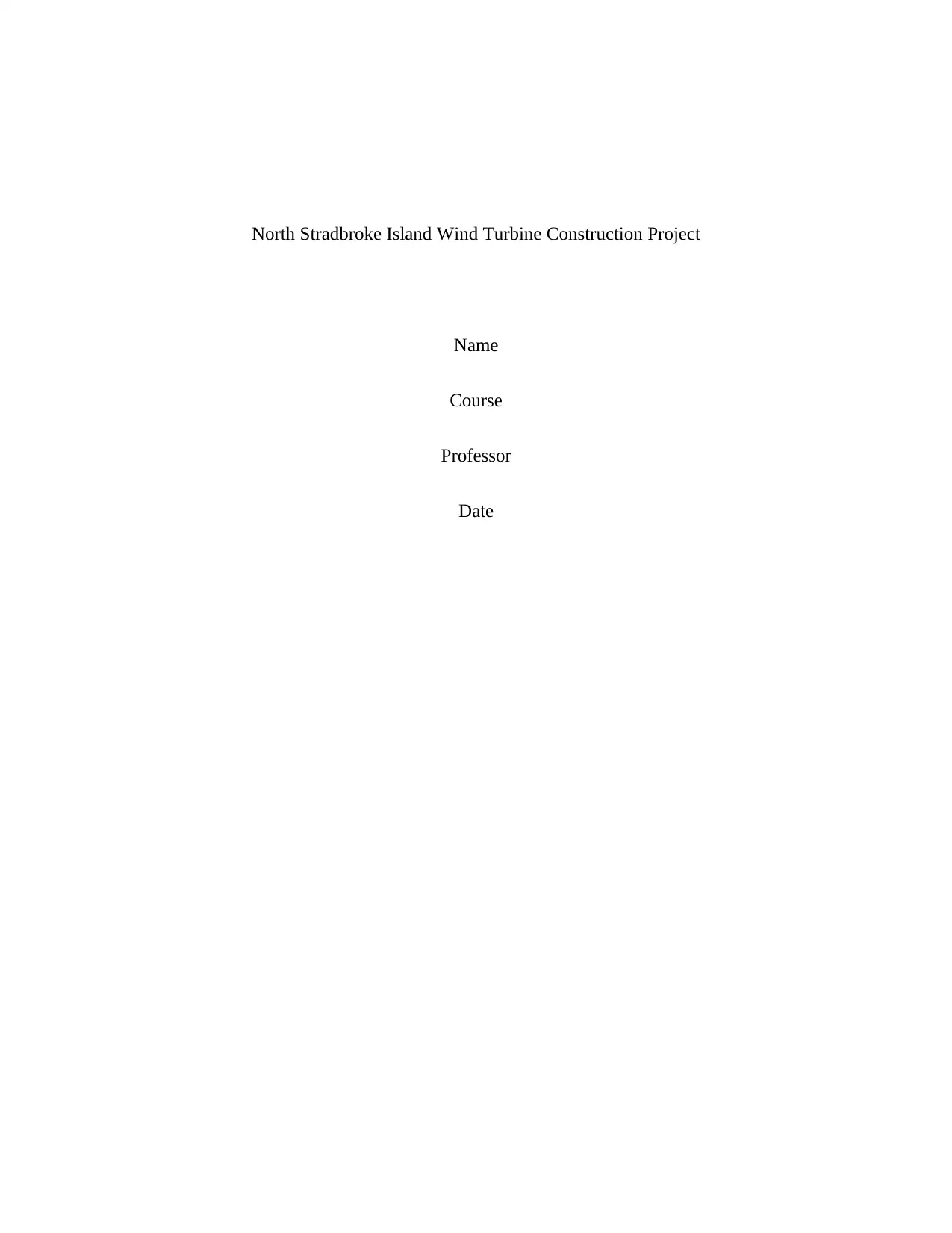
North Stradbroke Island Wind Turbine Construction Project
Name
Course
Professor
Date
Name
Course
Professor
Date
Paraphrase This Document
Need a fresh take? Get an instant paraphrase of this document with our AI Paraphraser
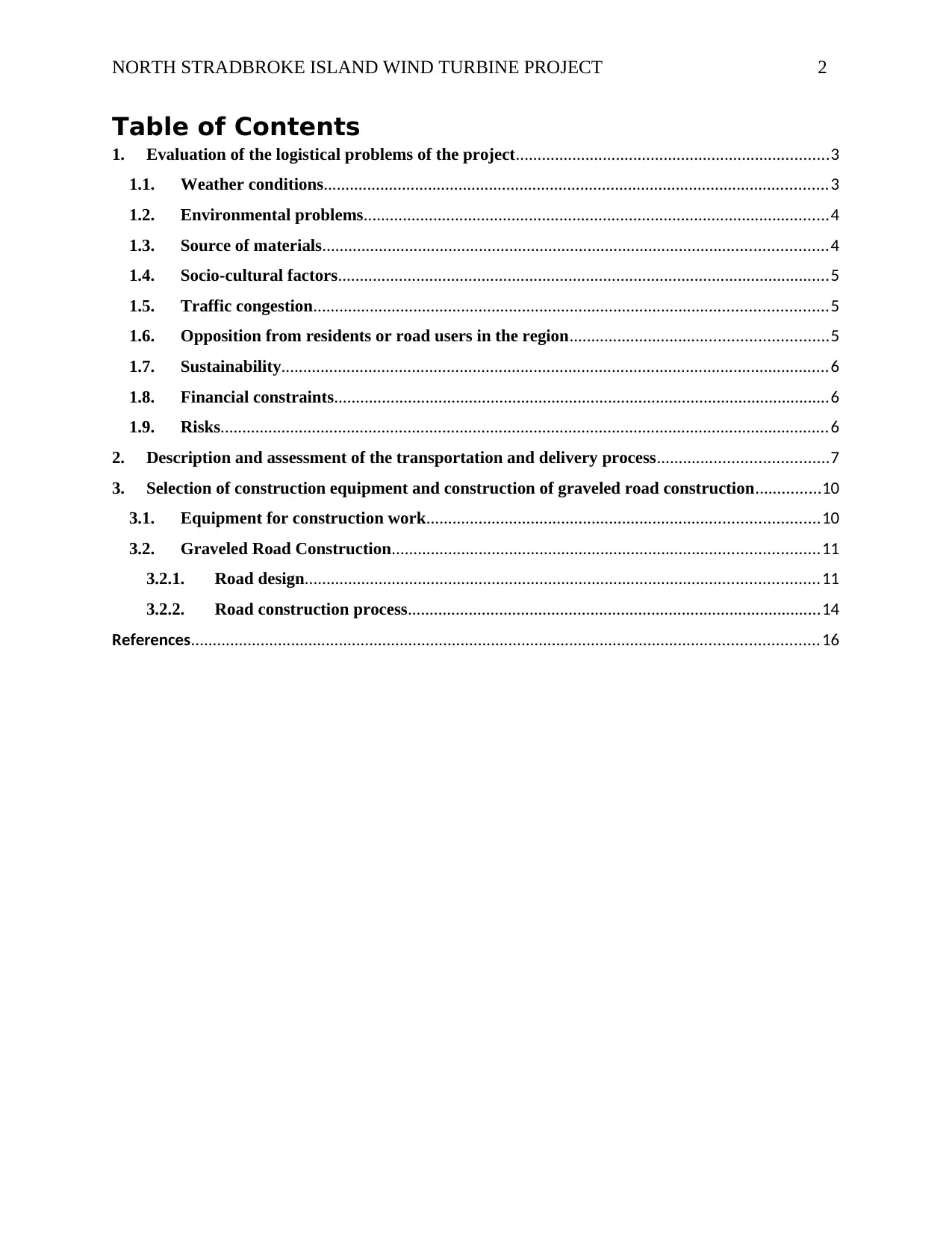
NORTH STRADBROKE ISLAND WIND TURBINE PROJECT 2
Table of Contents
1. Evaluation of the logistical problems of the project........................................................................3
1.1. Weather conditions....................................................................................................................3
1.2. Environmental problems...........................................................................................................4
1.3. Source of materials....................................................................................................................4
1.4. Socio-cultural factors.................................................................................................................5
1.5. Traffic congestion......................................................................................................................5
1.6. Opposition from residents or road users in the region...........................................................5
1.7. Sustainability..............................................................................................................................6
1.8. Financial constraints..................................................................................................................6
1.9. Risks............................................................................................................................................6
2. Description and assessment of the transportation and delivery process.......................................7
3. Selection of construction equipment and construction of graveled road construction...............10
3.1. Equipment for construction work..........................................................................................10
3.2. Graveled Road Construction..................................................................................................11
3.2.1. Road design......................................................................................................................11
3.2.2. Road construction process...............................................................................................14
References................................................................................................................................................16
Table of Contents
1. Evaluation of the logistical problems of the project........................................................................3
1.1. Weather conditions....................................................................................................................3
1.2. Environmental problems...........................................................................................................4
1.3. Source of materials....................................................................................................................4
1.4. Socio-cultural factors.................................................................................................................5
1.5. Traffic congestion......................................................................................................................5
1.6. Opposition from residents or road users in the region...........................................................5
1.7. Sustainability..............................................................................................................................6
1.8. Financial constraints..................................................................................................................6
1.9. Risks............................................................................................................................................6
2. Description and assessment of the transportation and delivery process.......................................7
3. Selection of construction equipment and construction of graveled road construction...............10
3.1. Equipment for construction work..........................................................................................10
3.2. Graveled Road Construction..................................................................................................11
3.2.1. Road design......................................................................................................................11
3.2.2. Road construction process...............................................................................................14
References................................................................................................................................................16
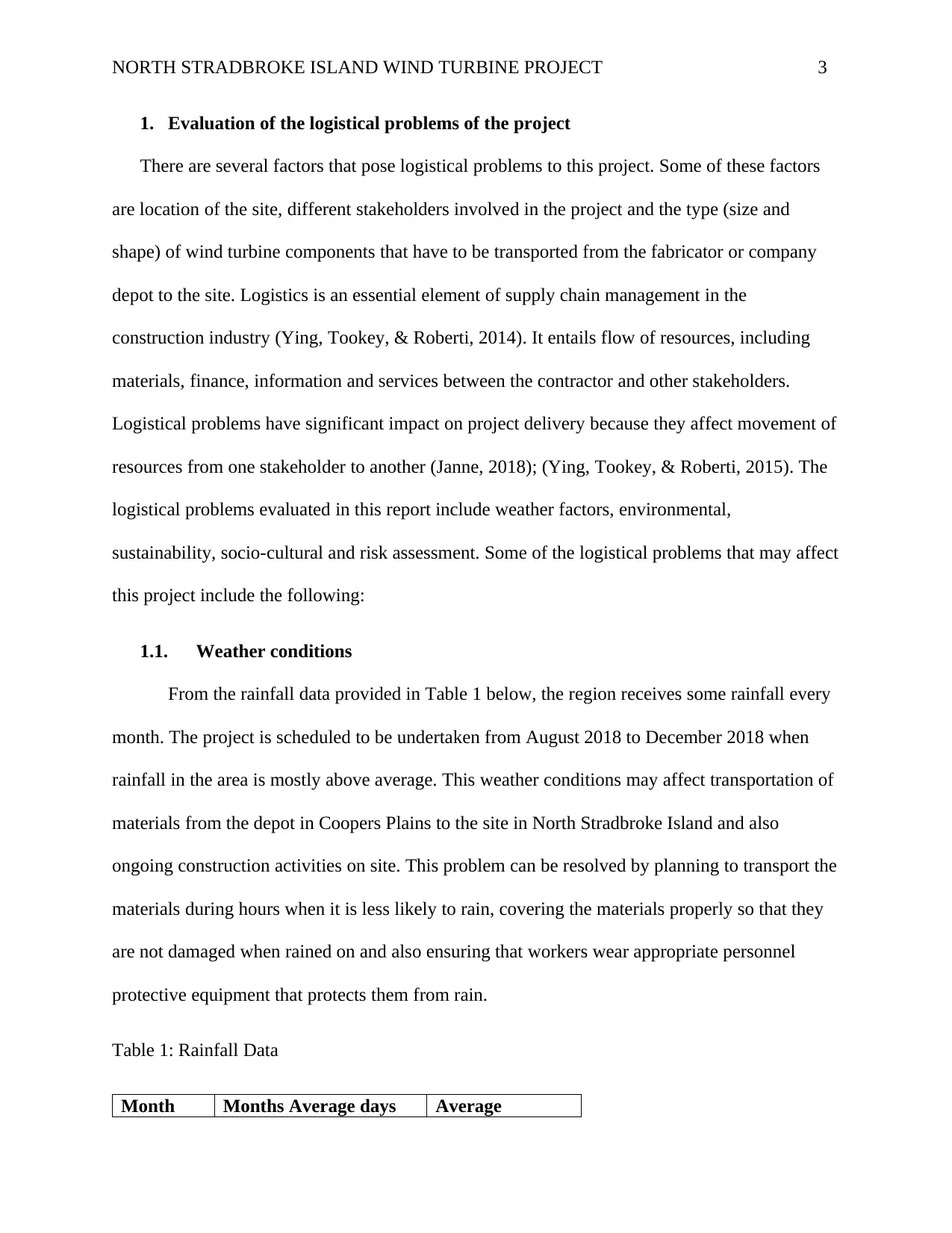
NORTH STRADBROKE ISLAND WIND TURBINE PROJECT 3
1. Evaluation of the logistical problems of the project
There are several factors that pose logistical problems to this project. Some of these factors
are location of the site, different stakeholders involved in the project and the type (size and
shape) of wind turbine components that have to be transported from the fabricator or company
depot to the site. Logistics is an essential element of supply chain management in the
construction industry (Ying, Tookey, & Roberti, 2014). It entails flow of resources, including
materials, finance, information and services between the contractor and other stakeholders.
Logistical problems have significant impact on project delivery because they affect movement of
resources from one stakeholder to another (Janne, 2018); (Ying, Tookey, & Roberti, 2015). The
logistical problems evaluated in this report include weather factors, environmental,
sustainability, socio-cultural and risk assessment. Some of the logistical problems that may affect
this project include the following:
1.1. Weather conditions
From the rainfall data provided in Table 1 below, the region receives some rainfall every
month. The project is scheduled to be undertaken from August 2018 to December 2018 when
rainfall in the area is mostly above average. This weather conditions may affect transportation of
materials from the depot in Coopers Plains to the site in North Stradbroke Island and also
ongoing construction activities on site. This problem can be resolved by planning to transport the
materials during hours when it is less likely to rain, covering the materials properly so that they
are not damaged when rained on and also ensuring that workers wear appropriate personnel
protective equipment that protects them from rain.
Table 1: Rainfall Data
Month Months Average days Average
1. Evaluation of the logistical problems of the project
There are several factors that pose logistical problems to this project. Some of these factors
are location of the site, different stakeholders involved in the project and the type (size and
shape) of wind turbine components that have to be transported from the fabricator or company
depot to the site. Logistics is an essential element of supply chain management in the
construction industry (Ying, Tookey, & Roberti, 2014). It entails flow of resources, including
materials, finance, information and services between the contractor and other stakeholders.
Logistical problems have significant impact on project delivery because they affect movement of
resources from one stakeholder to another (Janne, 2018); (Ying, Tookey, & Roberti, 2015). The
logistical problems evaluated in this report include weather factors, environmental,
sustainability, socio-cultural and risk assessment. Some of the logistical problems that may affect
this project include the following:
1.1. Weather conditions
From the rainfall data provided in Table 1 below, the region receives some rainfall every
month. The project is scheduled to be undertaken from August 2018 to December 2018 when
rainfall in the area is mostly above average. This weather conditions may affect transportation of
materials from the depot in Coopers Plains to the site in North Stradbroke Island and also
ongoing construction activities on site. This problem can be resolved by planning to transport the
materials during hours when it is less likely to rain, covering the materials properly so that they
are not damaged when rained on and also ensuring that workers wear appropriate personnel
protective equipment that protects them from rain.
Table 1: Rainfall Data
Month Months Average days Average
⊘ This is a preview!⊘
Do you want full access?
Subscribe today to unlock all pages.

Trusted by 1+ million students worldwide
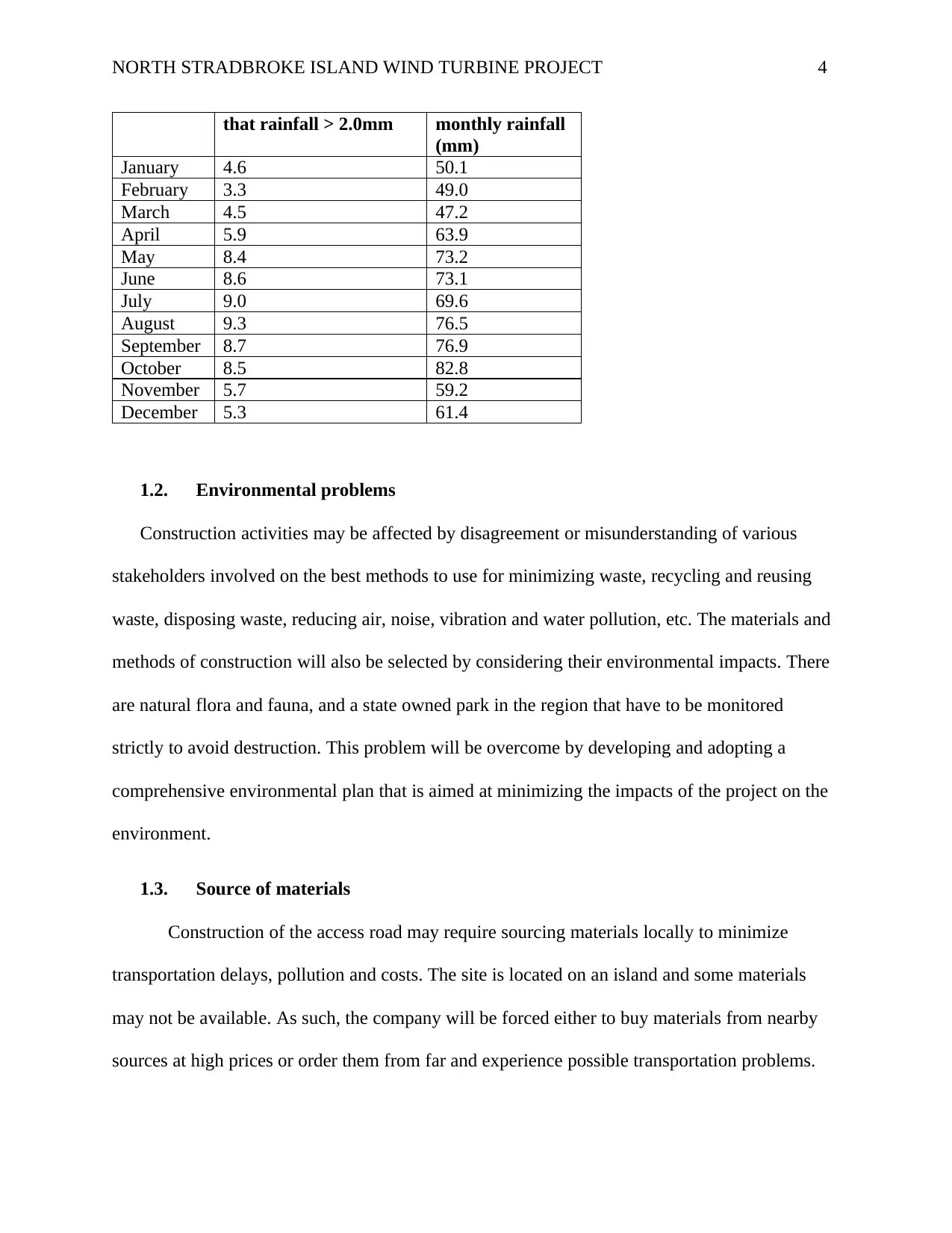
NORTH STRADBROKE ISLAND WIND TURBINE PROJECT 4
that rainfall > 2.0mm monthly rainfall
(mm)
January 4.6 50.1
February 3.3 49.0
March 4.5 47.2
April 5.9 63.9
May 8.4 73.2
June 8.6 73.1
July 9.0 69.6
August 9.3 76.5
September 8.7 76.9
October 8.5 82.8
November 5.7 59.2
December 5.3 61.4
1.2. Environmental problems
Construction activities may be affected by disagreement or misunderstanding of various
stakeholders involved on the best methods to use for minimizing waste, recycling and reusing
waste, disposing waste, reducing air, noise, vibration and water pollution, etc. The materials and
methods of construction will also be selected by considering their environmental impacts. There
are natural flora and fauna, and a state owned park in the region that have to be monitored
strictly to avoid destruction. This problem will be overcome by developing and adopting a
comprehensive environmental plan that is aimed at minimizing the impacts of the project on the
environment.
1.3. Source of materials
Construction of the access road may require sourcing materials locally to minimize
transportation delays, pollution and costs. The site is located on an island and some materials
may not be available. As such, the company will be forced either to buy materials from nearby
sources at high prices or order them from far and experience possible transportation problems.
that rainfall > 2.0mm monthly rainfall
(mm)
January 4.6 50.1
February 3.3 49.0
March 4.5 47.2
April 5.9 63.9
May 8.4 73.2
June 8.6 73.1
July 9.0 69.6
August 9.3 76.5
September 8.7 76.9
October 8.5 82.8
November 5.7 59.2
December 5.3 61.4
1.2. Environmental problems
Construction activities may be affected by disagreement or misunderstanding of various
stakeholders involved on the best methods to use for minimizing waste, recycling and reusing
waste, disposing waste, reducing air, noise, vibration and water pollution, etc. The materials and
methods of construction will also be selected by considering their environmental impacts. There
are natural flora and fauna, and a state owned park in the region that have to be monitored
strictly to avoid destruction. This problem will be overcome by developing and adopting a
comprehensive environmental plan that is aimed at minimizing the impacts of the project on the
environment.
1.3. Source of materials
Construction of the access road may require sourcing materials locally to minimize
transportation delays, pollution and costs. The site is located on an island and some materials
may not be available. As such, the company will be forced either to buy materials from nearby
sources at high prices or order them from far and experience possible transportation problems.
Paraphrase This Document
Need a fresh take? Get an instant paraphrase of this document with our AI Paraphraser

NORTH STRADBROKE ISLAND WIND TURBINE PROJECT 5
1.4. Socio-cultural factors
These factors include variables such as language, attitude of local communities, educational
levels, lifestyles, values and norms, etc. Construction projects involve stakeholder with varied
levels of knowledge and skills. Some of the stakeholders such as interest groups, local
community and the general public may not have any technical knowledge about the problem and
therefore it takes time to explain to them about some technical elements of the project. One
strategy of resolving these problems is ensuring that project managers and supervisors develop
and adopt appropriate management and leadership styles (Engobo, 2009). This will help in
ensuring that all stakeholders are handled based on their “special” needs so as to avoid or
minimize conflicts and disputes.
1.5. Traffic congestion
This is a logistical problem that cannot be avoided. The materials will mainly be transported
on city roads and ferry where the likelihood of traffic congestion is high due to the large urban
population (Radziszewska-Zielina & Kania, 2017). Considering the weight and dimensions of
the wind turbine components, traffic may be diverted thus affecting road users and this may
cause opposition to the project. However, the problem can be overcome by collaborating with
relevant government agencies to organize for traffic diversion or road closure.
1.6. Opposition from residents or road users in the region
Activities related to this project may be a nuisance to local communities. This includes
traffic congestion caused in the region, air pollution, high noise levels, dust, etc. (Ayarkwa &
Agyekum, 2014). These problems can be overcome by ensuring adequate consultation and
collaboration between the company and all other stakeholders, including the communities and
the general public (Samuelsson & Ahmetasevic, 2014).
1.4. Socio-cultural factors
These factors include variables such as language, attitude of local communities, educational
levels, lifestyles, values and norms, etc. Construction projects involve stakeholder with varied
levels of knowledge and skills. Some of the stakeholders such as interest groups, local
community and the general public may not have any technical knowledge about the problem and
therefore it takes time to explain to them about some technical elements of the project. One
strategy of resolving these problems is ensuring that project managers and supervisors develop
and adopt appropriate management and leadership styles (Engobo, 2009). This will help in
ensuring that all stakeholders are handled based on their “special” needs so as to avoid or
minimize conflicts and disputes.
1.5. Traffic congestion
This is a logistical problem that cannot be avoided. The materials will mainly be transported
on city roads and ferry where the likelihood of traffic congestion is high due to the large urban
population (Radziszewska-Zielina & Kania, 2017). Considering the weight and dimensions of
the wind turbine components, traffic may be diverted thus affecting road users and this may
cause opposition to the project. However, the problem can be overcome by collaborating with
relevant government agencies to organize for traffic diversion or road closure.
1.6. Opposition from residents or road users in the region
Activities related to this project may be a nuisance to local communities. This includes
traffic congestion caused in the region, air pollution, high noise levels, dust, etc. (Ayarkwa &
Agyekum, 2014). These problems can be overcome by ensuring adequate consultation and
collaboration between the company and all other stakeholders, including the communities and
the general public (Samuelsson & Ahmetasevic, 2014).
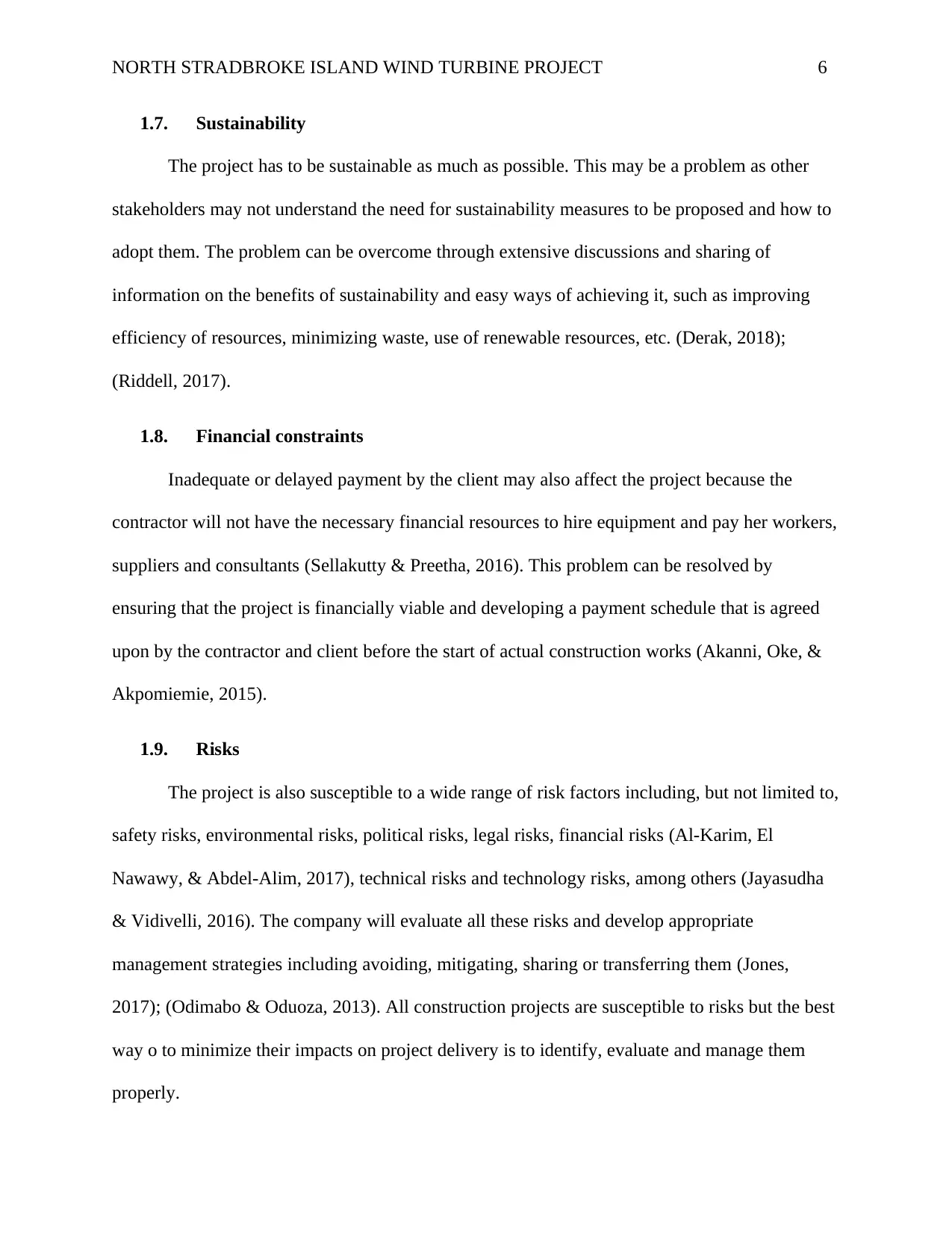
NORTH STRADBROKE ISLAND WIND TURBINE PROJECT 6
1.7. Sustainability
The project has to be sustainable as much as possible. This may be a problem as other
stakeholders may not understand the need for sustainability measures to be proposed and how to
adopt them. The problem can be overcome through extensive discussions and sharing of
information on the benefits of sustainability and easy ways of achieving it, such as improving
efficiency of resources, minimizing waste, use of renewable resources, etc. (Derak, 2018);
(Riddell, 2017).
1.8. Financial constraints
Inadequate or delayed payment by the client may also affect the project because the
contractor will not have the necessary financial resources to hire equipment and pay her workers,
suppliers and consultants (Sellakutty & Preetha, 2016). This problem can be resolved by
ensuring that the project is financially viable and developing a payment schedule that is agreed
upon by the contractor and client before the start of actual construction works (Akanni, Oke, &
Akpomiemie, 2015).
1.9. Risks
The project is also susceptible to a wide range of risk factors including, but not limited to,
safety risks, environmental risks, political risks, legal risks, financial risks (Al-Karim, El
Nawawy, & Abdel-Alim, 2017), technical risks and technology risks, among others (Jayasudha
& Vidivelli, 2016). The company will evaluate all these risks and develop appropriate
management strategies including avoiding, mitigating, sharing or transferring them (Jones,
2017); (Odimabo & Oduoza, 2013). All construction projects are susceptible to risks but the best
way o to minimize their impacts on project delivery is to identify, evaluate and manage them
properly.
1.7. Sustainability
The project has to be sustainable as much as possible. This may be a problem as other
stakeholders may not understand the need for sustainability measures to be proposed and how to
adopt them. The problem can be overcome through extensive discussions and sharing of
information on the benefits of sustainability and easy ways of achieving it, such as improving
efficiency of resources, minimizing waste, use of renewable resources, etc. (Derak, 2018);
(Riddell, 2017).
1.8. Financial constraints
Inadequate or delayed payment by the client may also affect the project because the
contractor will not have the necessary financial resources to hire equipment and pay her workers,
suppliers and consultants (Sellakutty & Preetha, 2016). This problem can be resolved by
ensuring that the project is financially viable and developing a payment schedule that is agreed
upon by the contractor and client before the start of actual construction works (Akanni, Oke, &
Akpomiemie, 2015).
1.9. Risks
The project is also susceptible to a wide range of risk factors including, but not limited to,
safety risks, environmental risks, political risks, legal risks, financial risks (Al-Karim, El
Nawawy, & Abdel-Alim, 2017), technical risks and technology risks, among others (Jayasudha
& Vidivelli, 2016). The company will evaluate all these risks and develop appropriate
management strategies including avoiding, mitigating, sharing or transferring them (Jones,
2017); (Odimabo & Oduoza, 2013). All construction projects are susceptible to risks but the best
way o to minimize their impacts on project delivery is to identify, evaluate and manage them
properly.
⊘ This is a preview!⊘
Do you want full access?
Subscribe today to unlock all pages.

Trusted by 1+ million students worldwide
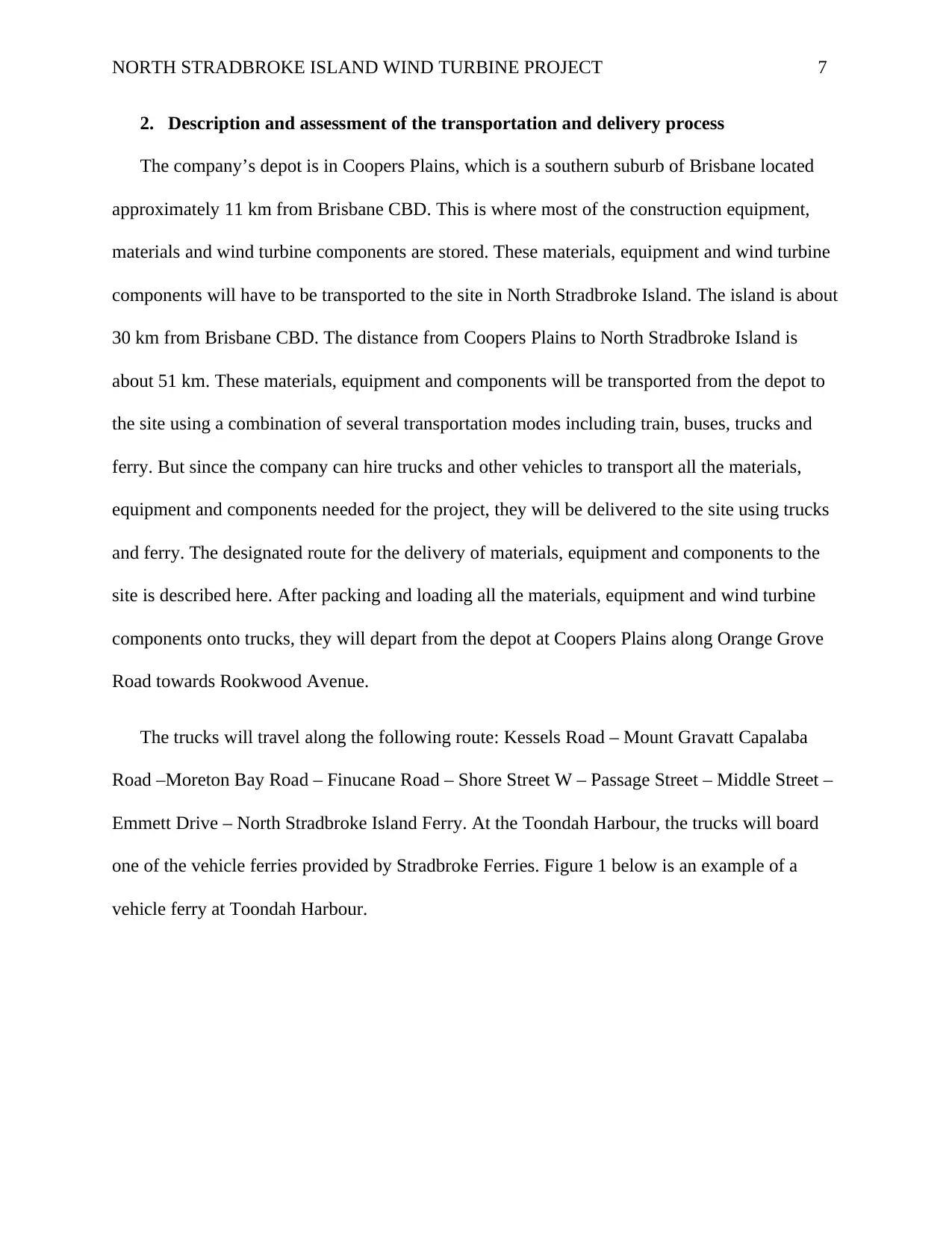
NORTH STRADBROKE ISLAND WIND TURBINE PROJECT 7
2. Description and assessment of the transportation and delivery process
The company’s depot is in Coopers Plains, which is a southern suburb of Brisbane located
approximately 11 km from Brisbane CBD. This is where most of the construction equipment,
materials and wind turbine components are stored. These materials, equipment and wind turbine
components will have to be transported to the site in North Stradbroke Island. The island is about
30 km from Brisbane CBD. The distance from Coopers Plains to North Stradbroke Island is
about 51 km. These materials, equipment and components will be transported from the depot to
the site using a combination of several transportation modes including train, buses, trucks and
ferry. But since the company can hire trucks and other vehicles to transport all the materials,
equipment and components needed for the project, they will be delivered to the site using trucks
and ferry. The designated route for the delivery of materials, equipment and components to the
site is described here. After packing and loading all the materials, equipment and wind turbine
components onto trucks, they will depart from the depot at Coopers Plains along Orange Grove
Road towards Rookwood Avenue.
The trucks will travel along the following route: Kessels Road – Mount Gravatt Capalaba
Road –Moreton Bay Road – Finucane Road – Shore Street W – Passage Street – Middle Street –
Emmett Drive – North Stradbroke Island Ferry. At the Toondah Harbour, the trucks will board
one of the vehicle ferries provided by Stradbroke Ferries. Figure 1 below is an example of a
vehicle ferry at Toondah Harbour.
2. Description and assessment of the transportation and delivery process
The company’s depot is in Coopers Plains, which is a southern suburb of Brisbane located
approximately 11 km from Brisbane CBD. This is where most of the construction equipment,
materials and wind turbine components are stored. These materials, equipment and wind turbine
components will have to be transported to the site in North Stradbroke Island. The island is about
30 km from Brisbane CBD. The distance from Coopers Plains to North Stradbroke Island is
about 51 km. These materials, equipment and components will be transported from the depot to
the site using a combination of several transportation modes including train, buses, trucks and
ferry. But since the company can hire trucks and other vehicles to transport all the materials,
equipment and components needed for the project, they will be delivered to the site using trucks
and ferry. The designated route for the delivery of materials, equipment and components to the
site is described here. After packing and loading all the materials, equipment and wind turbine
components onto trucks, they will depart from the depot at Coopers Plains along Orange Grove
Road towards Rookwood Avenue.
The trucks will travel along the following route: Kessels Road – Mount Gravatt Capalaba
Road –Moreton Bay Road – Finucane Road – Shore Street W – Passage Street – Middle Street –
Emmett Drive – North Stradbroke Island Ferry. At the Toondah Harbour, the trucks will board
one of the vehicle ferries provided by Stradbroke Ferries. Figure 1 below is an example of a
vehicle ferry at Toondah Harbour.
Paraphrase This Document
Need a fresh take? Get an instant paraphrase of this document with our AI Paraphraser
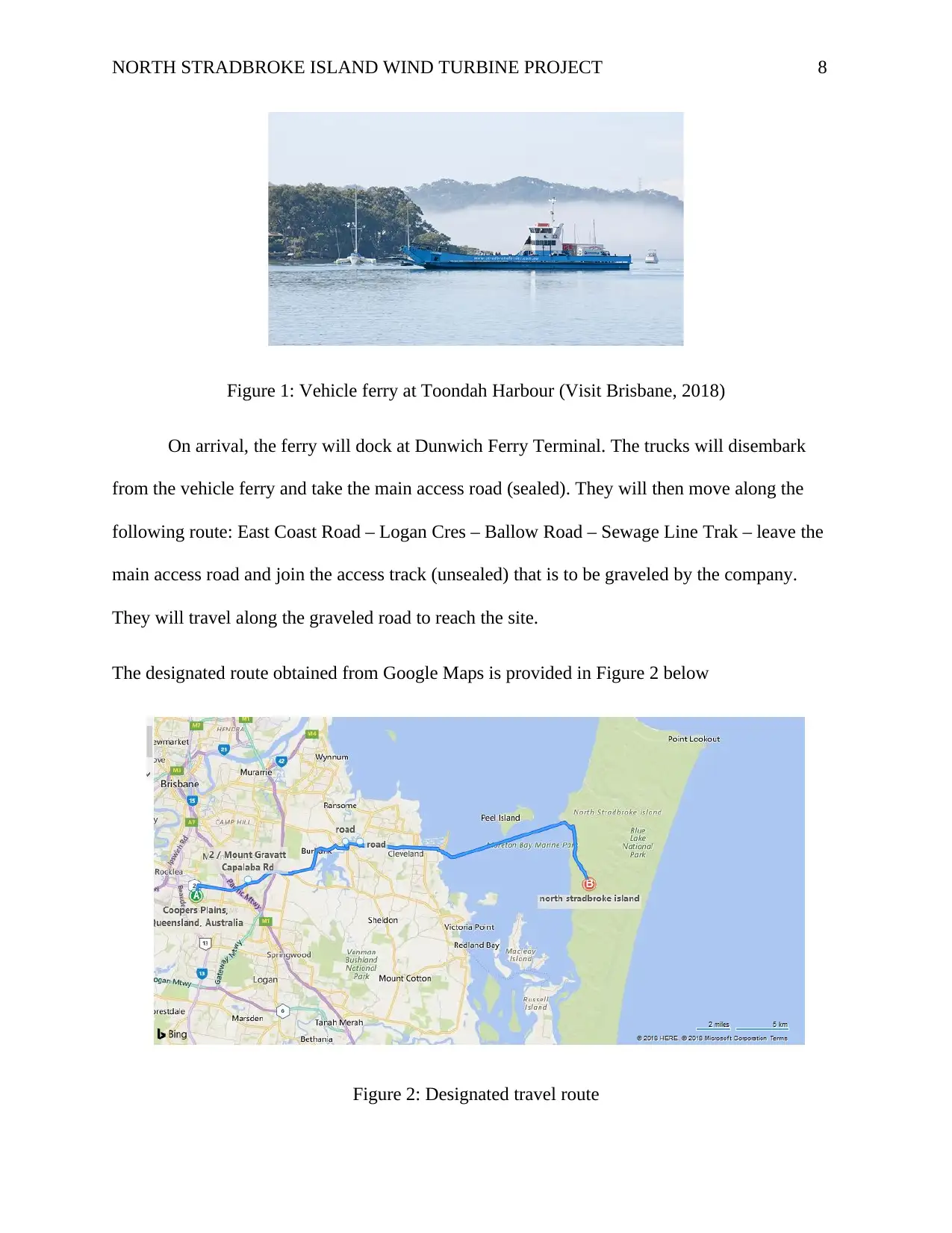
NORTH STRADBROKE ISLAND WIND TURBINE PROJECT 8
Figure 1: Vehicle ferry at Toondah Harbour (Visit Brisbane, 2018)
On arrival, the ferry will dock at Dunwich Ferry Terminal. The trucks will disembark
from the vehicle ferry and take the main access road (sealed). They will then move along the
following route: East Coast Road – Logan Cres – Ballow Road – Sewage Line Trak – leave the
main access road and join the access track (unsealed) that is to be graveled by the company.
They will travel along the graveled road to reach the site.
The designated route obtained from Google Maps is provided in Figure 2 below
Figure 2: Designated travel route
Figure 1: Vehicle ferry at Toondah Harbour (Visit Brisbane, 2018)
On arrival, the ferry will dock at Dunwich Ferry Terminal. The trucks will disembark
from the vehicle ferry and take the main access road (sealed). They will then move along the
following route: East Coast Road – Logan Cres – Ballow Road – Sewage Line Trak – leave the
main access road and join the access track (unsealed) that is to be graveled by the company.
They will travel along the graveled road to reach the site.
The designated route obtained from Google Maps is provided in Figure 2 below
Figure 2: Designated travel route
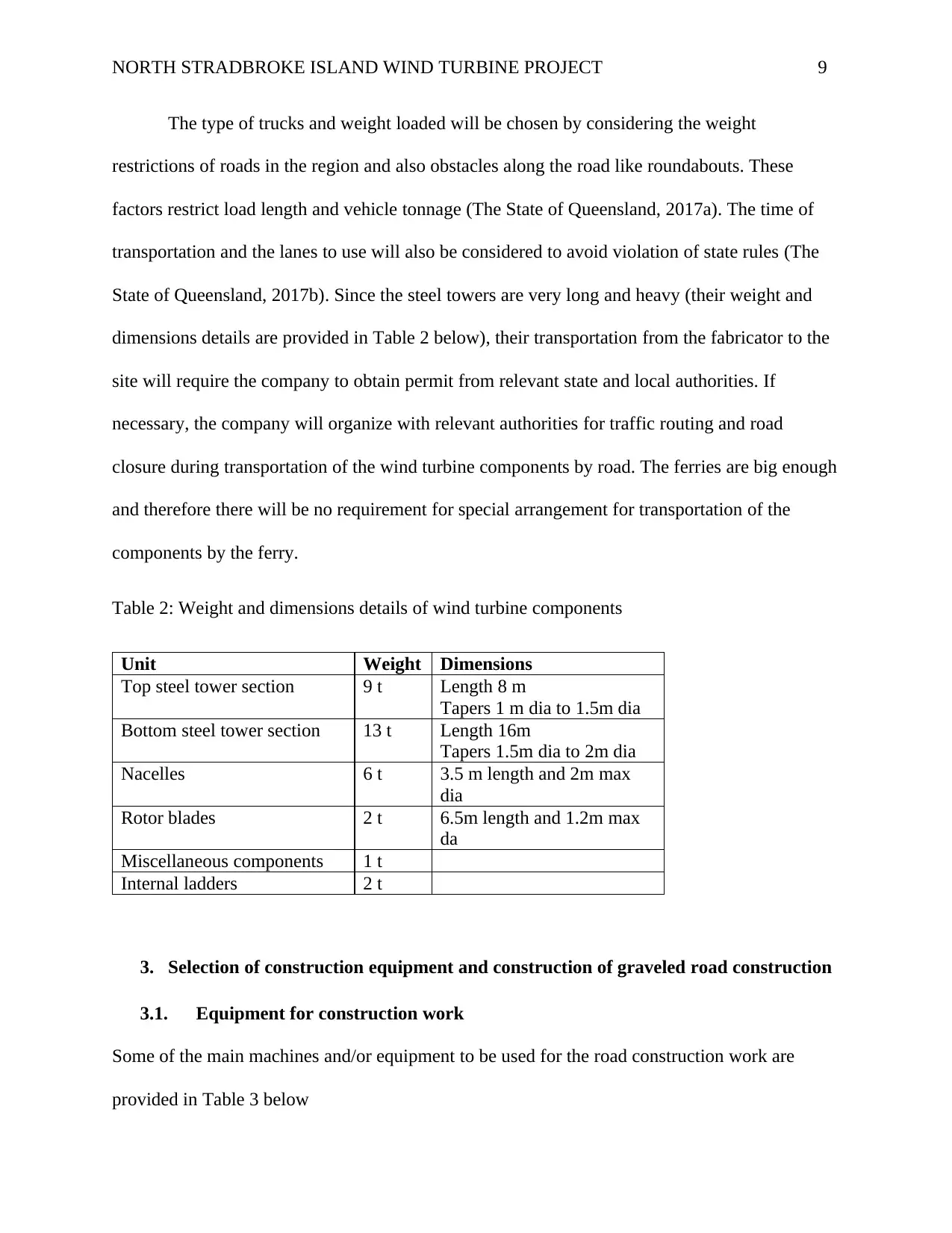
NORTH STRADBROKE ISLAND WIND TURBINE PROJECT 9
The type of trucks and weight loaded will be chosen by considering the weight
restrictions of roads in the region and also obstacles along the road like roundabouts. These
factors restrict load length and vehicle tonnage (The State of Queensland, 2017a). The time of
transportation and the lanes to use will also be considered to avoid violation of state rules (The
State of Queensland, 2017b). Since the steel towers are very long and heavy (their weight and
dimensions details are provided in Table 2 below), their transportation from the fabricator to the
site will require the company to obtain permit from relevant state and local authorities. If
necessary, the company will organize with relevant authorities for traffic routing and road
closure during transportation of the wind turbine components by road. The ferries are big enough
and therefore there will be no requirement for special arrangement for transportation of the
components by the ferry.
Table 2: Weight and dimensions details of wind turbine components
Unit Weight Dimensions
Top steel tower section 9 t Length 8 m
Tapers 1 m dia to 1.5m dia
Bottom steel tower section 13 t Length 16m
Tapers 1.5m dia to 2m dia
Nacelles 6 t 3.5 m length and 2m max
dia
Rotor blades 2 t 6.5m length and 1.2m max
da
Miscellaneous components 1 t
Internal ladders 2 t
3. Selection of construction equipment and construction of graveled road construction
3.1. Equipment for construction work
Some of the main machines and/or equipment to be used for the road construction work are
provided in Table 3 below
The type of trucks and weight loaded will be chosen by considering the weight
restrictions of roads in the region and also obstacles along the road like roundabouts. These
factors restrict load length and vehicle tonnage (The State of Queensland, 2017a). The time of
transportation and the lanes to use will also be considered to avoid violation of state rules (The
State of Queensland, 2017b). Since the steel towers are very long and heavy (their weight and
dimensions details are provided in Table 2 below), their transportation from the fabricator to the
site will require the company to obtain permit from relevant state and local authorities. If
necessary, the company will organize with relevant authorities for traffic routing and road
closure during transportation of the wind turbine components by road. The ferries are big enough
and therefore there will be no requirement for special arrangement for transportation of the
components by the ferry.
Table 2: Weight and dimensions details of wind turbine components
Unit Weight Dimensions
Top steel tower section 9 t Length 8 m
Tapers 1 m dia to 1.5m dia
Bottom steel tower section 13 t Length 16m
Tapers 1.5m dia to 2m dia
Nacelles 6 t 3.5 m length and 2m max
dia
Rotor blades 2 t 6.5m length and 1.2m max
da
Miscellaneous components 1 t
Internal ladders 2 t
3. Selection of construction equipment and construction of graveled road construction
3.1. Equipment for construction work
Some of the main machines and/or equipment to be used for the road construction work are
provided in Table 3 below
⊘ This is a preview!⊘
Do you want full access?
Subscribe today to unlock all pages.

Trusted by 1+ million students worldwide
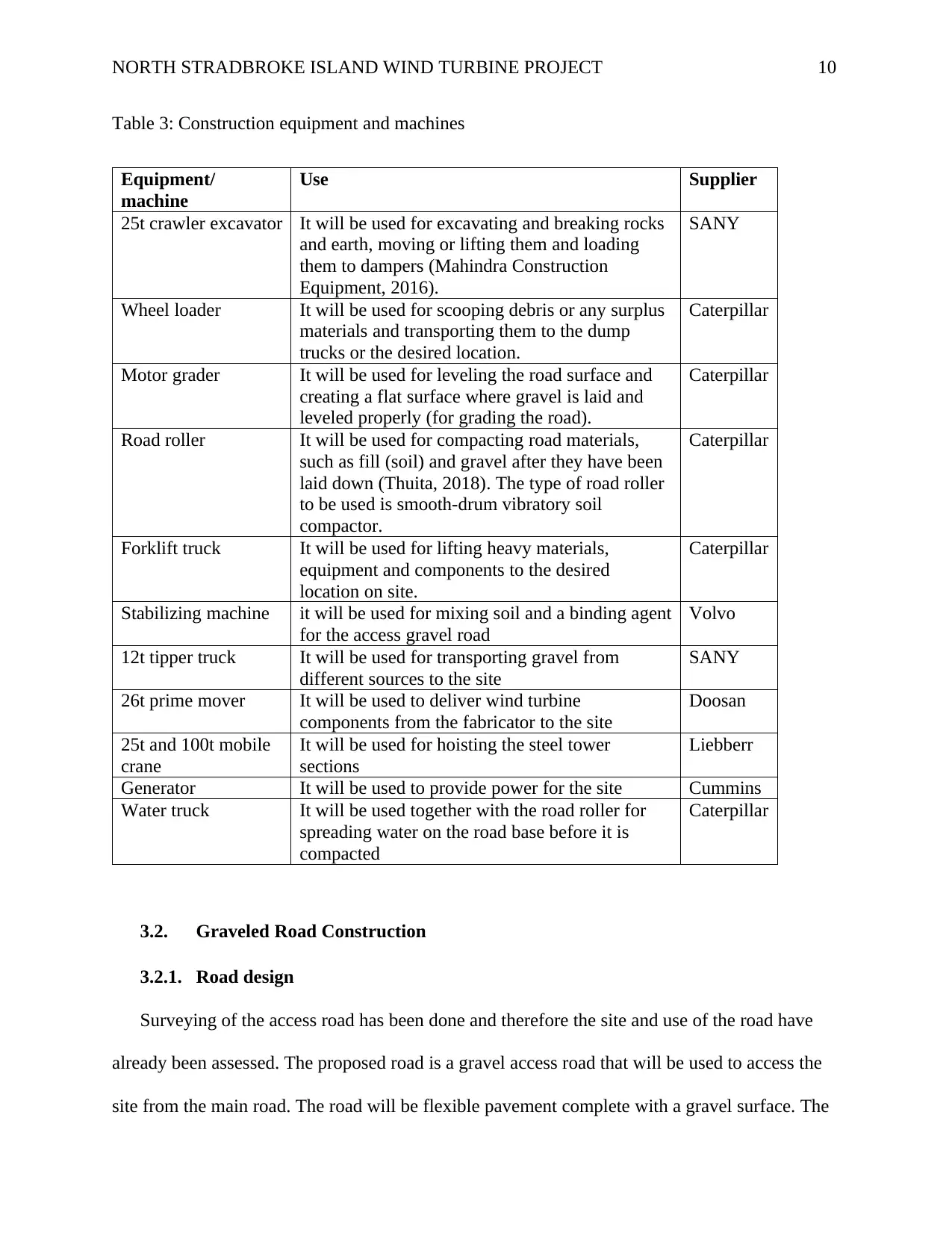
NORTH STRADBROKE ISLAND WIND TURBINE PROJECT 10
Table 3: Construction equipment and machines
Equipment/
machine
Use Supplier
25t crawler excavator It will be used for excavating and breaking rocks
and earth, moving or lifting them and loading
them to dampers (Mahindra Construction
Equipment, 2016).
SANY
Wheel loader It will be used for scooping debris or any surplus
materials and transporting them to the dump
trucks or the desired location.
Caterpillar
Motor grader It will be used for leveling the road surface and
creating a flat surface where gravel is laid and
leveled properly (for grading the road).
Caterpillar
Road roller It will be used for compacting road materials,
such as fill (soil) and gravel after they have been
laid down (Thuita, 2018). The type of road roller
to be used is smooth-drum vibratory soil
compactor.
Caterpillar
Forklift truck It will be used for lifting heavy materials,
equipment and components to the desired
location on site.
Caterpillar
Stabilizing machine it will be used for mixing soil and a binding agent
for the access gravel road
Volvo
12t tipper truck It will be used for transporting gravel from
different sources to the site
SANY
26t prime mover It will be used to deliver wind turbine
components from the fabricator to the site
Doosan
25t and 100t mobile
crane
It will be used for hoisting the steel tower
sections
Liebberr
Generator It will be used to provide power for the site Cummins
Water truck It will be used together with the road roller for
spreading water on the road base before it is
compacted
Caterpillar
3.2. Graveled Road Construction
3.2.1. Road design
Surveying of the access road has been done and therefore the site and use of the road have
already been assessed. The proposed road is a gravel access road that will be used to access the
site from the main road. The road will be flexible pavement complete with a gravel surface. The
Table 3: Construction equipment and machines
Equipment/
machine
Use Supplier
25t crawler excavator It will be used for excavating and breaking rocks
and earth, moving or lifting them and loading
them to dampers (Mahindra Construction
Equipment, 2016).
SANY
Wheel loader It will be used for scooping debris or any surplus
materials and transporting them to the dump
trucks or the desired location.
Caterpillar
Motor grader It will be used for leveling the road surface and
creating a flat surface where gravel is laid and
leveled properly (for grading the road).
Caterpillar
Road roller It will be used for compacting road materials,
such as fill (soil) and gravel after they have been
laid down (Thuita, 2018). The type of road roller
to be used is smooth-drum vibratory soil
compactor.
Caterpillar
Forklift truck It will be used for lifting heavy materials,
equipment and components to the desired
location on site.
Caterpillar
Stabilizing machine it will be used for mixing soil and a binding agent
for the access gravel road
Volvo
12t tipper truck It will be used for transporting gravel from
different sources to the site
SANY
26t prime mover It will be used to deliver wind turbine
components from the fabricator to the site
Doosan
25t and 100t mobile
crane
It will be used for hoisting the steel tower
sections
Liebberr
Generator It will be used to provide power for the site Cummins
Water truck It will be used together with the road roller for
spreading water on the road base before it is
compacted
Caterpillar
3.2. Graveled Road Construction
3.2.1. Road design
Surveying of the access road has been done and therefore the site and use of the road have
already been assessed. The proposed road is a gravel access road that will be used to access the
site from the main road. The road will be flexible pavement complete with a gravel surface. The
Paraphrase This Document
Need a fresh take? Get an instant paraphrase of this document with our AI Paraphraser
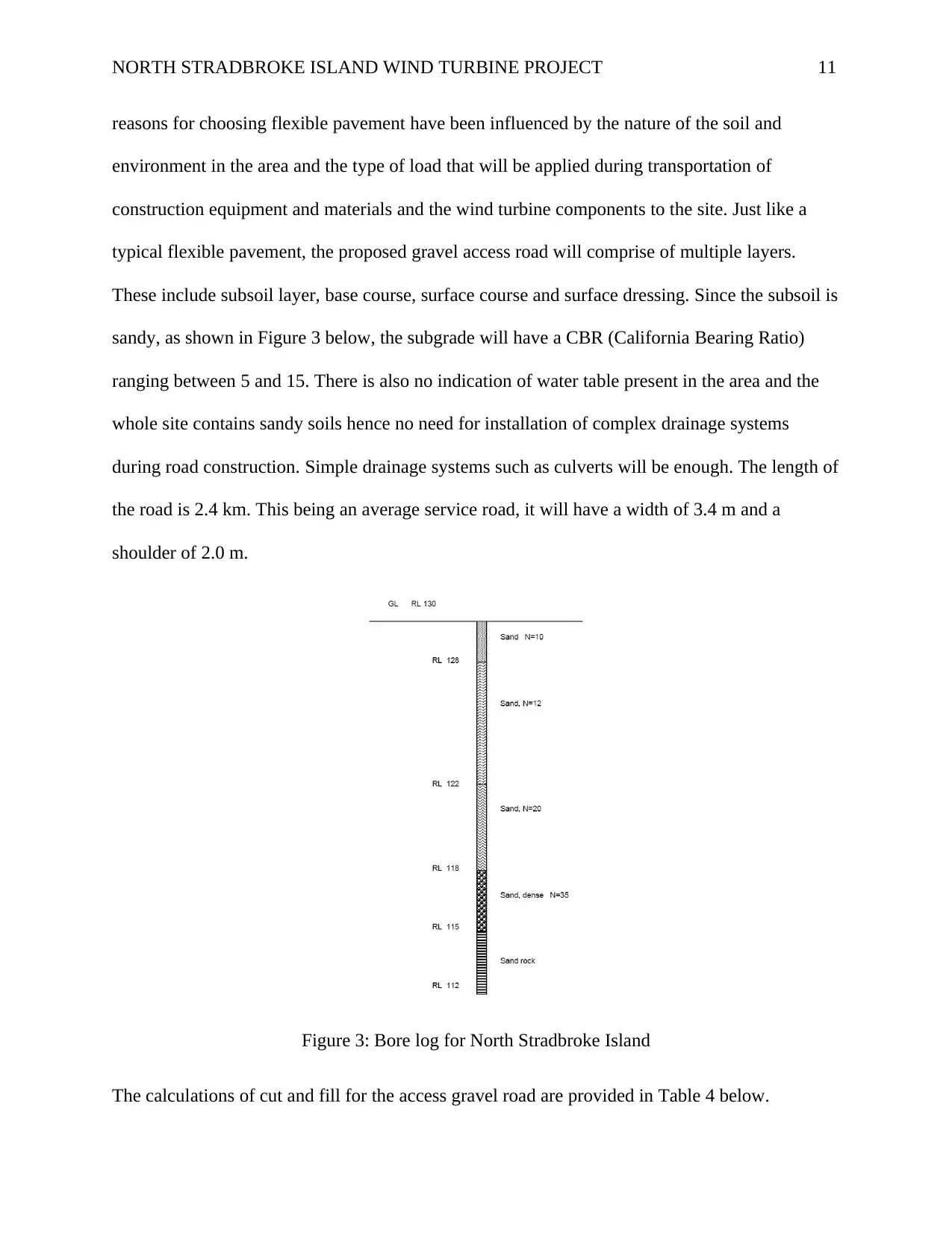
NORTH STRADBROKE ISLAND WIND TURBINE PROJECT 11
reasons for choosing flexible pavement have been influenced by the nature of the soil and
environment in the area and the type of load that will be applied during transportation of
construction equipment and materials and the wind turbine components to the site. Just like a
typical flexible pavement, the proposed gravel access road will comprise of multiple layers.
These include subsoil layer, base course, surface course and surface dressing. Since the subsoil is
sandy, as shown in Figure 3 below, the subgrade will have a CBR (California Bearing Ratio)
ranging between 5 and 15. There is also no indication of water table present in the area and the
whole site contains sandy soils hence no need for installation of complex drainage systems
during road construction. Simple drainage systems such as culverts will be enough. The length of
the road is 2.4 km. This being an average service road, it will have a width of 3.4 m and a
shoulder of 2.0 m.
Figure 3: Bore log for North Stradbroke Island
The calculations of cut and fill for the access gravel road are provided in Table 4 below.
reasons for choosing flexible pavement have been influenced by the nature of the soil and
environment in the area and the type of load that will be applied during transportation of
construction equipment and materials and the wind turbine components to the site. Just like a
typical flexible pavement, the proposed gravel access road will comprise of multiple layers.
These include subsoil layer, base course, surface course and surface dressing. Since the subsoil is
sandy, as shown in Figure 3 below, the subgrade will have a CBR (California Bearing Ratio)
ranging between 5 and 15. There is also no indication of water table present in the area and the
whole site contains sandy soils hence no need for installation of complex drainage systems
during road construction. Simple drainage systems such as culverts will be enough. The length of
the road is 2.4 km. This being an average service road, it will have a width of 3.4 m and a
shoulder of 2.0 m.
Figure 3: Bore log for North Stradbroke Island
The calculations of cut and fill for the access gravel road are provided in Table 4 below.

NORTH STRADBROKE ISLAND WIND TURBINE PROJECT 12
Table 4: Cut and fill volumes for the graveled access road
Chainage
(start)
Chainage
(end)
Cut (m3) Fill (m3) Fill inclusive of 10%
bulking factor (m3)
Cumulative
volume (m3)
0 200 1000 0 0 1000
200 400 1320 0 0 2320
400 600 0 420 462 1858
600 800 0 560 616 1242
800 1000 0 960 1056 186
1000 1200 0 980 1078 -892
1200 1400 0 880 968 -1860
1400 1600 0 600 660 -2520
1600 1800 1200 0 0 -1320
1800 2000 1100 0 0 -220
2000 2200 1000 0 0 780
2200 2400 1100 0 0 1880
The fill volume has been adjusted using a bulking factor of 10% because typically, 1 m3 of cut
or excavated material will not be enough to occupy 1 m3 of fill. This means that 1 m3 of fill
requires 1.1 m3 of cut material.
The mass haul diagrams of the road are provided in Figures 4 and 5 below
0 500 1000 1500 2000 2500 3000
-3000
-2000
-1000
0
1000
2000
3000
0
1000
2320
1858
1242
186
-892
-1860
-2520
-1320
-220
780
1880
Cumulative volume (m³) vs. chainage (m)
Chainage (m)
Cumulative volume (m³)
Figure 4: Mass haul diagram 1
Table 4: Cut and fill volumes for the graveled access road
Chainage
(start)
Chainage
(end)
Cut (m3) Fill (m3) Fill inclusive of 10%
bulking factor (m3)
Cumulative
volume (m3)
0 200 1000 0 0 1000
200 400 1320 0 0 2320
400 600 0 420 462 1858
600 800 0 560 616 1242
800 1000 0 960 1056 186
1000 1200 0 980 1078 -892
1200 1400 0 880 968 -1860
1400 1600 0 600 660 -2520
1600 1800 1200 0 0 -1320
1800 2000 1100 0 0 -220
2000 2200 1000 0 0 780
2200 2400 1100 0 0 1880
The fill volume has been adjusted using a bulking factor of 10% because typically, 1 m3 of cut
or excavated material will not be enough to occupy 1 m3 of fill. This means that 1 m3 of fill
requires 1.1 m3 of cut material.
The mass haul diagrams of the road are provided in Figures 4 and 5 below
0 500 1000 1500 2000 2500 3000
-3000
-2000
-1000
0
1000
2000
3000
0
1000
2320
1858
1242
186
-892
-1860
-2520
-1320
-220
780
1880
Cumulative volume (m³) vs. chainage (m)
Chainage (m)
Cumulative volume (m³)
Figure 4: Mass haul diagram 1
⊘ This is a preview!⊘
Do you want full access?
Subscribe today to unlock all pages.

Trusted by 1+ million students worldwide
1 out of 17
Your All-in-One AI-Powered Toolkit for Academic Success.
+13062052269
info@desklib.com
Available 24*7 on WhatsApp / Email
![[object Object]](/_next/static/media/star-bottom.7253800d.svg)
Unlock your academic potential
Copyright © 2020–2025 A2Z Services. All Rights Reserved. Developed and managed by ZUCOL.